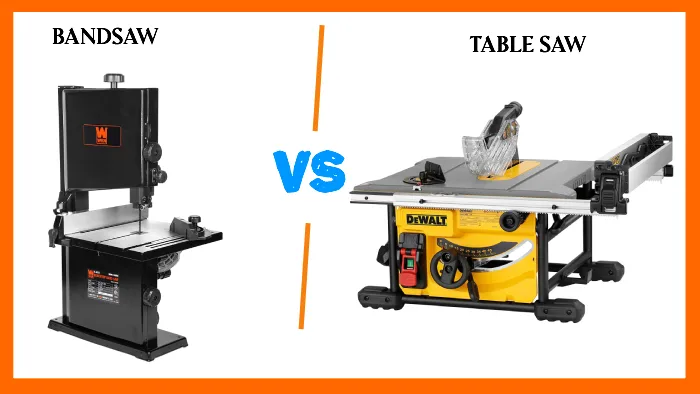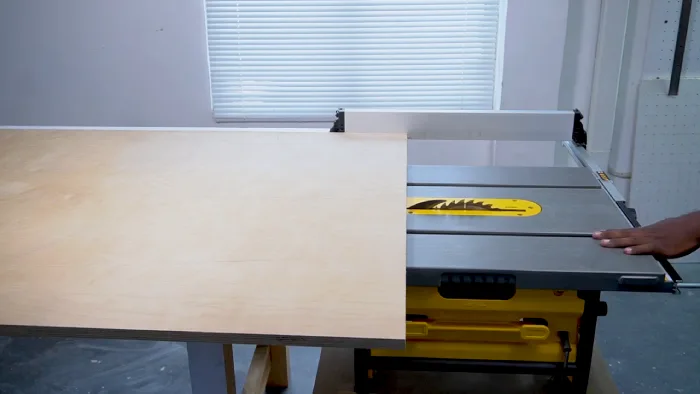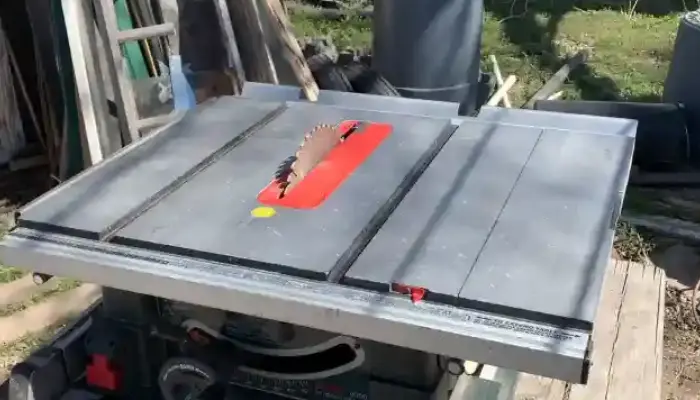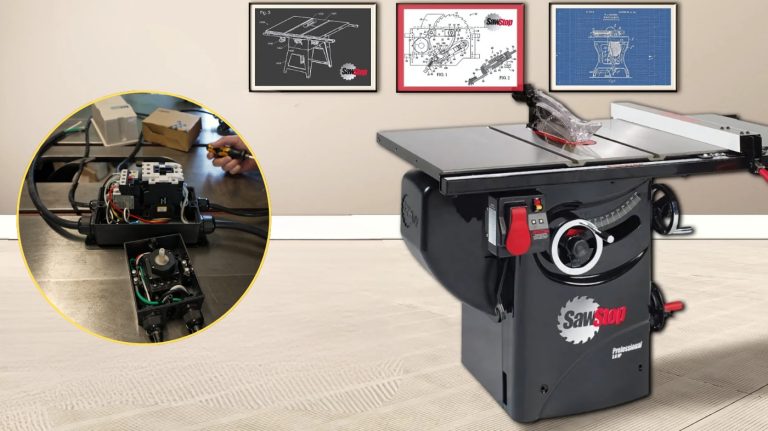Bandsaw vs Table Saw: 11 Key Differences [Must-Know]
As a woodworking enthusiast, I’ve always been fascinated by the debate between band saws and table saws. These saws have features and capabilities, but deciding which one to buy can be challenging. Through my research, I’ve realized what’s best for you depends greatly on your needs, preferences, and budget.
When comparing cutting styles and applications, they differ greatly, with a bandsaw excelling in curved and irregular cuts, while a table saw is more suitable for straight cuts. The cutting depth and capacity vary, as a bandsaw can typically handle thicker materials, while a table saw is better for thinner stock.
In this article, I’ll provide an in-depth analysis of bandsaw vs table saw, focusing on their differences. By the end of this article, you’ll better understand which saw is right for you.
- Powerful 2.8-amp motor, 2500 RPM
- Cuts 3-1/2″ deep, 9″ wide
- Bevels up to 45 degrees
- Uses 59-1/2″ blades, 1/8-3/8″ width
- Spacious work table, versatile cuts
- Powerful 15 Amp Motor
- 32-1/2 Inch Rip Capacity
- Rack & Pinion Fence System
- Rolling Stand for Portability
- Versatile Applications for Woodworking
Significant Differences Between Bandsaw and Table Saw

Both machines bring unique capabilities, catering to different needs and preferences. I suggest you understand the following differences when comparing a bandsaw and a table saw.
- Cutting styles and applications
- Cutting depth and capacity
- Precision in narrow cuts
- Footprint and space efficiency
- Dust collection
- Blade changes and adjustments
- Versatility in cuts
- Mobility and portability
- Noise level
- Safety features
- Budget considerations
1. Cutting Styles and Applications
Bandsaws and table saws have distinct cutting styles and applications, making them essential tools for different woodworking needs.
Table saws are known for their ability to make precise, clean, or angle straight cuts, making them the preferred choice for projects that require accuracy. They excel at cutting plywood and performing ‘square work,’ making them a staple in cabinet and furniture shops.
On the other hand, bandsaws have a narrow, flexible blade that easily cuts curves and odd shapes. They’re inherently safer for many cuts, reducing the risk of kickback. Bandsaws are ideal for woodworkers specializing in free-form curves or projects with limited space.
2. Cutting Depth and Capacity
Table saws can make deeper cuts, which is particularly suitable for working with long hardwoods and handling substantial pieces. They are known for their ability to cut through thicker materials, making them ideal for projects that require deeper cuts.
Conversely, bandsaws may have a limited cutting depth compared to table saws. However, bandsaws excel in precision for curves, circles, and shorter rip cuts. They are particularly adept at resawing lumber to create thinner planks or veneers.
3. Precision in Narrow Cuts
Table saws excel in making wider cuts with precision, but they may face challenges when it comes to narrow pieces. Support and stability become crucial for achieving accurate cuts on these smaller workpieces.
Alternatively, bandsaws with their continuous loop blade offer greater control and precision when working on narrow pieces. The ability to maneuver the blade around tight curves and intricate shapes makes bandsaws an excellent choice for intricate and detailed woodworking tasks.
4. Footprint and Space Efficiency
With its larger footprint and demand for more floor space, the table saw can hinder smaller workshops and compact setups. Table saws are known for their workhorse capabilities in woodworking, but their size can limit their usability in tighter spaces.
Alternatively, bandsaws offer a more space-efficient solution. With their smaller footprint, bandsaws can be placed against a wall, allowing for better utilization of limited workshop space. This advantage is particularly beneficial for woodworkers working in compact setups.
5. Dust Collection
For efficient dust collection, bandsaws offer a simpler solution than table saws, thanks to their equipped collection bags and downward-cutting motion.
Table saws typically require more complex dust collection systems, adding to cost and setup time. The nature of the cuts, especially with larger pieces, generates more sawdust that needs efficient extraction.
As an alternative, bandsaws are often equipped with a collection bag, providing a straightforward method for managing sawdust. The narrower blade and downward cutting motion contribute to a cleaner workspace, making bandsaws a more practical option for dust collection.
6. Blade Changes and Adjustments
Unlike the relatively easy process on a table saw, changing blades on a bandsaw requires adjustments to tension, tracking, bearings, and potentially the fence, making it a more involved and time-consuming task.
When replacing the blade on a bandsaw, you must adjust the tension to ensure it’s properly tightened. This is crucial for a clean and accurate cut. You must also adjust the tracking, which controls the blade’s position on the wheels, to maintain proper alignment.
The bearings also need attention, as they support the blade and facilitate smooth movement. Finally, the fence may need adjustments to ensure it’s parallel to the blade, enabling precise cuts.
7. Versatility in Cuts

The bandsaw and table saw offer significant differences in cut versatility, making them distinct tools for various woodworking applications. Table saws excel in long, straight, and square cuts, making them suitable for various woodworking tasks. They’re precision tools designed for accuracy in well-defined cuts.
Meanwhile, bandsaws offer curved cuts and cutting capacity advantages, especially in resawing lumber. Their continuous loop blade allows for intricate shapes, providing greater flexibility in woodworking projects. As a result of their versatility, bandsaws are perfect for making scrollwork and irregular shapes.
8. Mobility and Portability
Although some portable models are available, table saws are generally less mobile due to their larger size and weight. Portable variants often sacrifice certain features found in their stationary counterparts.
On the other hand, bandsaws tend to be more portable, especially smaller benchtop versions. Additionally, some bandsaws are designed for greater mobility, allowing woodworkers to bring the tool to different job sites or areas within the workshop without much hassle.
9. Noise Level
Table saws are notably louder and require ear protection to mitigate the noise. They are known for their noisy operation, contributing to noise pollution in the workshop. The high noise level can be disruptive and uncomfortable for users, necessitating ear protection.
Contrary to this, bandsaws operate more quietly. With proper ear protection, they are suitable for home use. The reduced noise level of bandsaws creates a more comfortable working environment, minimizing disturbance. This makes bandsaws a popular choice for those who value a quieter workspace.
10. Safety Features
Regarding safety features, there are significant differences between band saws and table saws. Table saws, while versatile, can be dangerous due to the risk of kickback and material pinching.
However, modern table saws have safety features such as splitters, riving knives, and anti-kickback pawls to address these dangers. Splitters prevent the material from closing in on the back of the blade, reducing the risk of kickback.
Riving knives, positioned close to the blade, prevent the material from pinching the blade and causing it to kick back. Anti-kickback pawls, attached to the splitter, grab the wood if it starts to move backward, preventing kickback.
Meanwhile, bandsaws are generally considered safer due to their downward cutting force, which reduces the risk of kickback. Blade guards protect against accidental contact with the blade, while kickback brakes immediately stop the blade if kickback occurs.
11. Budget Considerations
Budget-friendly table saw options can provide similar capabilities to more expensive models, making them a viable choice for cost-conscious woodworkers. These table saws often offer adjustable fences, miter gauges, and dust collection systems, allowing for precise cuts and a cleaner work area.
On the other hand, budget bandsaws may lack essential features that can affect their performance and versatility. It’s often recommended to save for a more capable bandsaw to ensure optimal cutting power, blade tension control, and the ability to handle thicker and larger materials.
Comparison Table Between Bandsaw & Table Saw
| Aspect | Bandsaws | Table Saws |
| Cutting Styles and Applications | Ideal for curved cuts, intricate shapes, and resawing lumber. | Efficient for straight cuts, especially in plywood and square work. |
| Footprint and Space Efficiency | Smaller footprint can be placed against a wall. | Larger footprint, demands significant floor space. |
| Blade Changes and Adjustments | More involved process with adjustments to tension, tracking, and bearings. | Relatively easy and quick blade changes. |
| Versatility in Cuts | Excel in curved cuts, resawing, and various materials. | Excel in long, straight, and square cuts. |
| Safety Features | Generally considered safer, reduced risk of kickback. | Potential dangers like kickback and material pinching. |
| Budget Considerations | Saving for a more capable bandsaw is recommended. | Budget-friendly options may offer similar capabilities. |
| Cutting Depth and Capacity | Limited cutting depth; excels in precision for curves. | Deeper cuts, suitable for thicker materials. |
| Dust Collection | Equipped with a collection bag, a simpler solution. | Requires more complex systems, adding to cost and setup time. |
| Noise Level | Operates more quietly, suitable for home use. | Noisy operation, requiring ear protection. |
| Material Variety | Versatile, capable of cutting various materials. | Primarily designed for wood, with limited versatility. |
| Precision in Narrow Cuts | Greater control and precision for narrow pieces. | Excel in wider cuts; may face challenges with narrow pieces. |
Can a bandsaw replace a table saw?
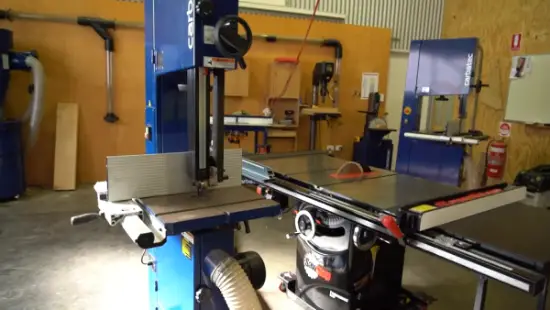
A bandsaw can serve as a viable alternative to a table saw for various woodworking tasks. While a table saw is known for its clean, straight, and accurate cuts, a bandsaw can still achieve satisfactory results in many cases.
With its unique design and blade configuration, a bandsaw excels at cutting curves, irregular shapes, and intricate details. It’s particularly useful for resawing lumber, cutting veneers, and creating intricate joinery.
Do I really need a bandsaw?
To determine if a bandsaw is necessary for your woodworking projects, consider the specific tasks you’ll be undertaking and the precision and versatility required. Bandsaws are incredibly useful tools that offer unique capabilities that other saws, such as table saws can’t replicate.
One of the main advantages of a bandsaw is its ability to easily cut curves and irregular shapes. This makes it an essential tool for tasks like cutting intricate designs or creating curved pieces of furniture.
Why would you need a table saw?
Table saws, with their ability to enhance accuracy and efficiency, are an indispensable tool for any woodworking enthusiast or professional. When making straight cuts, a table saw is unmatched in its precision.
The blade, the key component of a table saw, plays a crucial role in creating clean and accurate cuts. Investing in a high-quality blade will save you significant time in the long run.
Choose the Right Saw for Your Woodworking Projects
The choice ultimately depends on individual preferences, workshop space, and the nature of the work at hand. While table saws shine in precise, clean, and straight cuts, bandsaws offer unmatched versatility, making them indispensable for curved cuts and intricate woodworking projects.
Whether you opt for one, the other, or both, understanding these major differences will guide you toward the right decision for your woodworking endeavors. Ultimately, the choice between the two depends on the specific needs of the user and the type of woodworking projects they undertake.
So, whether you opt for a bandsaw or table saw, remember to choose the tool that best suits your requirements and happy woodworking.
- Powerful 2.8 Amp Induction Motor
- 2-Speed Drive System for Versatility
- Quick Blade Tension Setting
- Precision Ball Bearing and Guides
- Rack and Pinion Table Adjustment
- Powerful 15 Amp Motor for Precision
- 32.5 Inch Rip Capacity for Versatility
- Durable Rack and Pinion Fence
- Professional-Grade 5-Year Warranty
- One-Step Folding Stand for Mobility
Last update on 2025-12-25 / Affiliate links / Images from Amazon Product Advertising API

